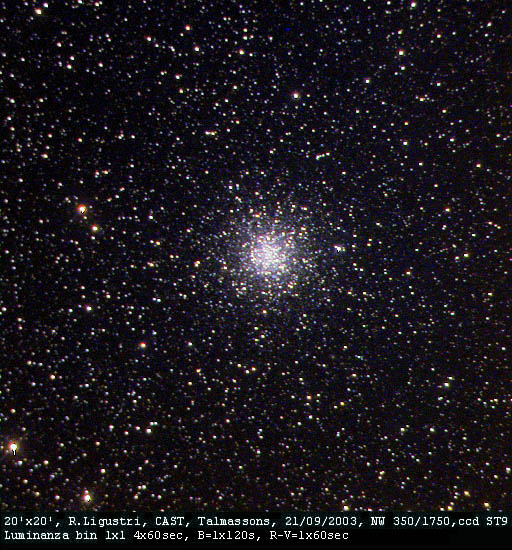 |
21/09/2003 | Immagine di Rolando LIGUSTRI |
Ripresa dall'Osservatorio Astronomico di Talmassons (Ud) |
Sezione Deep Sky |
 | ||||
| AMMASSO GLOBULARE M 56 - NGC 6779 | ||||
| Altre classificazioni: GCL 110 | ||||
| Tipo: X ; Catalogo NGC: glob. cl., B, L, iR, gvmCM, rrr, st 11...14; = M | ||||
| Ascensione retta: 19h 16m 35.5s; declinazione: +30° 11' 05" (J2000.0) | ||||
| Asse maggiore: 5.00 minuti d'arco; magnitudine: 8.3 | ||||
| Distanza 17.200 kp | ||||
Prima immagine dell'ammasso globulare M 56-NGC 6779, situato nella costellazione della Lira (LYRA-LYR): è una ripresa ccd a colori del settembre 2003. E' un oggetto piuttosto trascurato dagli astrofili, non perché privo di stelle d'una certa luminosità e nemmeno perché disperso (anzi è un globulare piuttosto compatto), ma forse per la sua relativamente bassa luminosità complessiva (è di ottava magnitudine) e perché i suoi "simili" M 13 e M 15 sono molto più ripresi.
Nella nostra immagine si contano solamente qualche centinaio di stelle, ma nella realtà esso dovrebbe esser composto da decine di migliaia di astri, molto
impaccati nella struttura tridimensionale intuibile anche nell'inquadratura di Ligustri.  Di seguito riporto alcune delle note rintracciate sul Guide 8.0.
Note dal Catalogo NGC2000:
Commenti dalle Osservazioni di Steve Coe:
Commenti tratti dal SAC (Saguaro Astronomy Club) 7.2:  Quest'immagine ha una dimensione di 512 x 550 pixel, è a 16,8 milioni di colori, occupa una dimensione di 1,6 MB qui compressi a 111 KB. Il campo della ripresa è di 20' x 20' d'arco, mentre la risoluzione è di 2,35"/pixel. | ||||
| Telescopio Riflettore: Newton da 350 mm di diametro; lunghezza focale: 1750 mm; f/5 | ||||
| CCD: SBIG ST9E (KAF 261) | ||||
| Tempo d'integrazione Luminanza: somma di 4 pose da 60 secondi in binning 1x1 | ||||
| Tempo d'integrazione crominanza Blu: 1 posa da 120 secondi | ||||
| Tempo d'integrazione crominanze Verde e Rossa: 1 posa da 60 secondi | ||||
| Filtri impiegati: Cousins (rosso) e Johnson (verde e blu) | ||||
Ammassi |
Oggetti Messier |
Fotografia, ccd e ricerca |
Articoli |
Dizionario
| ||||
